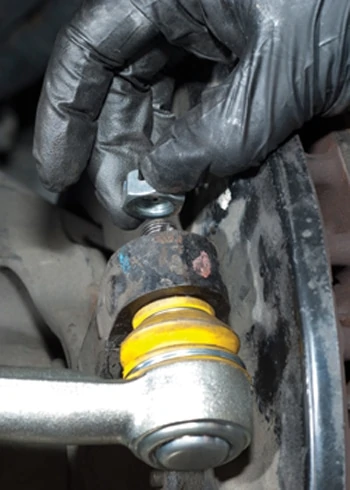Joint Health
By Tim Walton Photos by Larry Walton
Worn out suspension components can lead to tire wear. This condition also makes the vehicle less responsive and generally unpleasant to drive. The number and location of ball joints can vary depending on what type of suspension your vehicle has. The ball joints allow movement in your suspension so it can conform to the contours of the road.
If a ball joint goes bad, it does not allow the wheel and tire of the vehicle to move as intended, which can not only cause undesired tire wear but also be potentially dangerous if the joint itself fails completely. Most of the joints are designed to be non-serviceable. However, if the boot wears out or is torn, they will lose their grease and wear at an accelerated rate. Some joints do have grease fittings where you can reapply grease and should be inspected when the vehicle is serviced.
A ball joint failing often makes a clicking noise, grinding noise or even a clunking noise when going over a bump. One way to diagnose ball joints is to lift the vehicle until the tires clear the ground and apply pressure to the wheel. You are feeling for extra movement or “slop”. Check to make sure the movement is from the ball joint and not from something else such as the wheel bearing.
On this Subaru, we’re also addressing another issue that comes with vehicles that have aftermarket suspension, which is to reduce bump steer that can occur when you lower the vehicle. This kit from Whiteline includes extended ball joints and outer tie rod ends to move the pivot point of both suspension components to correct for the change in ride height.
When a vehicle is lowered, the angle of the tie rods and lower control arm can add more body roll in addition to the undesirable bump-steer feedback in the steering wheel. While this installation addresses these issues on a lowered car, the same installation process applies to replacing worn parts on a stock car.
Whiteline’s Roll Center Adjustment Kit comes with a pair of outer tie rods and a pair of ball joints to replace the stock units. If you’re replacing factory equipment parts with similar geometry, the parts will be sold individually rather than in a kit.
We removed the wheels from the vehicle. If you’re not lucky enough to have a lift, be sure to place jack stands at the proper points to safely support the vehicle.
Removing the front sway bar end links allows the control arms to move independently, which gave us the movement in the control arm we needed to remove the lower ball joint.
The outer tie rod is connected to the spindle using a castle-type nut. A cotter pin holds the castle nut in place and must be removed before the 19 mm nut can be removed.
The cotter pin and castle nut needs to be removed from the bottom of the ball joint so it can be removed from the control arm.
We used a pneumatic impact wrench to make short work of removing the castle nuts that hold the lower ball joints in place.
A deep socket gave us the clearance over the rotor and dust shield, to remove the castle nut holding the outer tie rod.
Depending on the age of the car and the amount of rust on the ball joints, they may come out easily or be a real challenge.
A ball joint removal tool makes short work of removing the ball joint. The tool can also save the stock ball joints and grease-filled boot, which in this case were still in good condition.
The constant force applied to the ball joint by the tool will pop it loose and won’t damage threads or other components that might come with trying to hammer them loose.
Remove the bolt that holds the top of the ball joint in the steering knuckle.
You can use a small pry bar or a sturdy flat-blade screwdriver to pry apart the knuckle to release the ball joint from the steering knuckle.
This model of Subaru Impreza, the STi, uses alloy sleeve inserts that fit over the steel tapered stud on the ball joint to adapt them to the aluminum lower control arms. Make sure to transfer them over to the Whiteline ball joints.
You can apply anti-seize on the ball joint to aid in removing them at a later time. It prevents the ball joint from rusting into the steering knuckle as well.
Installing the ball joint required some prying. A floor jack can help push the control arm into position, which allows you to insert the bolt to hold it into place.
Measuring and/or marking the length of the tie rod ends can help you keep the vehicle’s alignment close to what it was before the install. However, you should take the vehicle to get an alignment check any time you do a major overhaul of the suspension components.
We used two wrenches to free the lock nut, which holds the outer tie rod end in place.
Once the tie rod is loose, you should be able to spin it off freely and replace it with the Whiteline replacement tie rod end. Try to get it close to the same location as the original tie rod. We locked the tie rod end into place using the lock nut and manufacturer’s torque rating.
We reinstalled the tie rod ends and ball joints using the new castle nuts supplied in the kit.
Tighten and torque the ball joint and tie rod end components to the manufacturers specified torque ratings, which can be found with some research.
We reattached the sway bar, which we removed earlier to move the control arms. Double-check that everything is tightened and torqued.
You may have to rotate the castle nuts to get the cotter pins to fit into the holes. Bend them over so they don’t fall out.
Other Automotive Related Articles



![[01] LW_12_02661](https://extremehowto.com/wp-content/uploads/2013/09/01-LW_12_02661.webp)
![[02] LW_12_02653](https://extremehowto.com/wp-content/uploads/2013/09/02-LW_12_02653.webp)
![[03] LW_12_02686](https://extremehowto.com/wp-content/uploads/2013/09/03-LW_12_02686.webp)
![[04] LW_12_02694](https://extremehowto.com/wp-content/uploads/2013/09/04-LW_12_02694.webp)
![[05] LW_12_02691](https://extremehowto.com/wp-content/uploads/2013/09/05-LW_12_02691.webp)
![[06] LW_12_02703](https://extremehowto.com/wp-content/uploads/2013/09/06-LW_12_02703.webp)
![[07] LW_12_02705](https://extremehowto.com/wp-content/uploads/2013/09/07-LW_12_02705.webp)
![[08] LW_12_02708](https://extremehowto.com/wp-content/uploads/2013/09/08-LW_12_02708.webp)
![[09] LW_12_02727](https://extremehowto.com/wp-content/uploads/2013/09/09-LW_12_02727.webp)
![[10] LW_12_02733](https://extremehowto.com/wp-content/uploads/2013/09/10-LW_12_02733.webp)
![[11] LW_12_02739](https://extremehowto.com/wp-content/uploads/2013/09/11-LW_12_02739.webp)
![[12] LW_12_02744](https://extremehowto.com/wp-content/uploads/2013/09/12-LW_12_02744.webp)
![[13] LW_12_02749](https://extremehowto.com/wp-content/uploads/2013/09/13-LW_12_02749.webp)
![[14] LW_12_02751](https://extremehowto.com/wp-content/uploads/2013/09/14-LW_12_02751.webp)
![[15] LW_12_02758](https://extremehowto.com/wp-content/uploads/2013/09/15-LW_12_02758.webp)
![[16] LW_12_02768](https://extremehowto.com/wp-content/uploads/2013/09/16-LW_12_02768.webp)
![[17] LW_12_02774](https://extremehowto.com/wp-content/uploads/2013/09/17-LW_12_02774.webp)
![[18] LW_12_02784](https://extremehowto.com/wp-content/uploads/2013/09/18-LW_12_02784.webp)
![[19] LW_12_02789](https://extremehowto.com/wp-content/uploads/2013/09/19-LW_12_02789.webp)
![[20] LW_12_02791](https://extremehowto.com/wp-content/uploads/2013/09/20-LW_12_02791.webp)
![[21] LW_12_02795](https://extremehowto.com/wp-content/uploads/2013/09/21-LW_12_02795.webp)
![[22] LW_12_02802](https://extremehowto.com/wp-content/uploads/2013/09/22-LW_12_02802.webp)
